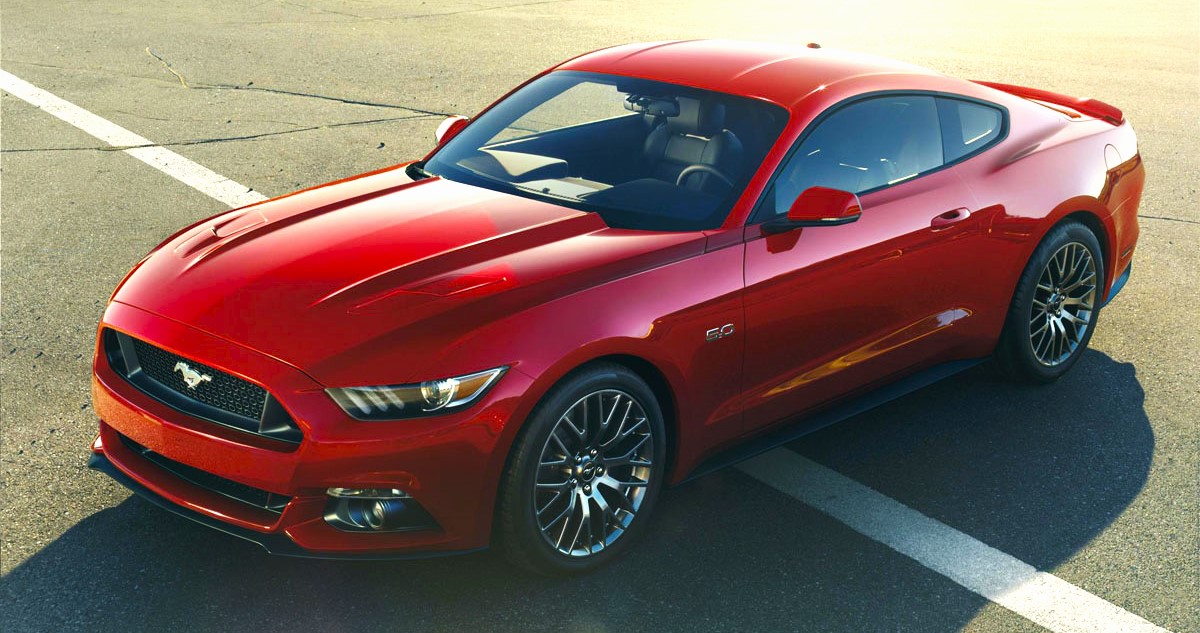
FORD MUSTANG MARKS 50 YEARS WITH ALL-NEW SLEEK DESIGN, INNOVATIVE TECHNOLOGIES AND WORLD-CLASS PERFORMANCE
- All-new sophisticated design clearly inspired by 50 years of Mustang heritage evolved to attract wider array of customers and expand global market availability
- Mustang now available with three engines offering a broader power of choice – a more powerful 5.0-liter V8, a 3.7-liter V6 and an all-new fuel-efficient 2.3-liter EcoBoost® engine
- Mustang sets new performance and dynamics benchmarks for the brand with world-class handling, more precise steering control and enhanced ride comfort
The next chapter in the life of the iconic pony car begins today as the all-new Ford Mustang – loaded with innovative technologies and delivering world-class levels of performance – is simultaneously revealed around the globe in six cities on four continents.
“Ford Mustang inspires passion like no other car,” said Raj Nair, Ford group vice president, global product development. “The visceral look, sound and performance of Mustang resonates with people, even if they’ve never driven one. Mustang is definitely more than just a car – it is the heart and soul of Ford.”
Mustang’s impact goes well beyond the 9 million-plus cars sold in its 50 years of continuous production. It has made thousands of appearances in film, television, music and video games, and is the world’s most-liked vehicle on Facebook. For the first time ever, Ford will bring Mustang to customers in key parts of Europe and Asia.
“We crafted this car with the goal of creating a contemporary interpretation of Mustang – an American automotive icon that symbolizes optimism and freedom for millions of people around the world,” said Jim Farley, executive vice president of Ford global marketing, sales and service and Lincoln.
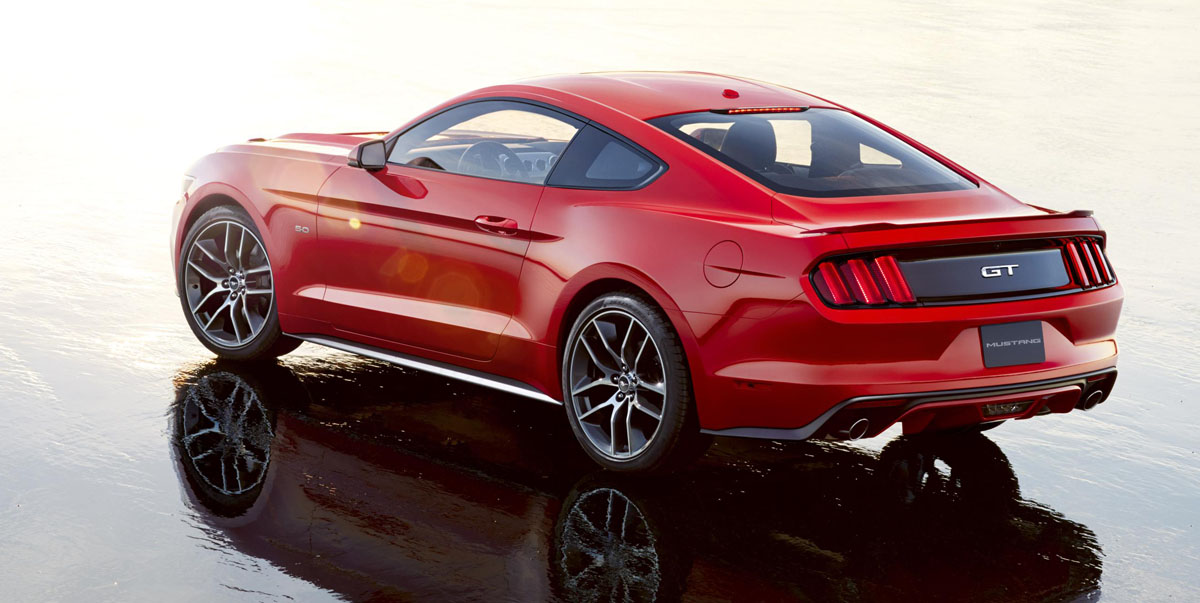
All-new shape, yet unmistakably Mustang
The clean-sheet design of both Mustang fastback and convertible evokes the essential character of the brand, retaining key design elements – including the long sculpted hood and short rear deck – with contemporary execution.
“You only get one chance to make a first impression, and when you see this car you immediately see a Mustang strong and true,” said Moray Callum, Ford executive director, design, The Americas.
Several key design features define the all-new Mustang, including:
- A lower, wider stance with a reduction in roof height, and wider rear fenders and track
- The return of Mustang fastback with a sleeker profile enabled by more steeply sloped windshield and rear glass
- Three-dimensional, tri-bar taillamps with sequential turn signals
- Contemporary execution of the signature shark-bite front fascia and trapezoidal grille
Mustang convertible drivers will appreciate the standard multilayer insulated cloth top that gives the car a more upscale appearance and a quieter cabin. The new top lowers twice as fast as before, and has a sleeker profile when folded for open-air motoring.
The information and controls an active driver needs are all readily accessible in the aviation-inspired cockpit, which is executed with the highest degree of craftsmanship ever found in a Mustang. Large, clear instrumentation puts vehicle information right in front of the driver in the roomier cabin, while improved ergonomics and tactile switches and knobs provide better control. The added width and a new rear suspension contribute to improved shoulder and hip room for passengers, and a more usefully shaped trunk can accommodate two golf bags.
The Mustang experience
The way Mustang looks, drives and sounds is key to the visceral experience that makes drivers just want to get in and hit the road. With more options to choose from, there is a Mustang to fit any lifestyle. The upgraded V6 and V8 are joined by an all-new 2.3-liter EcoBoost® engine that brings state-of-the-art technology to Mustang.
Mustang GT continues with the latest edition of the throaty 5.0-liter V8, now featuring an upgraded valvetrain and cylinder heads that yield more than 420 horsepower and 390 lb.-ft. of torque. A new intake manifold improves low-speed breathing for better fuel economy, idle stability and emissions.
“This EcoBoost engine delivers where a Mustang driver expects it to, with a broad, flat torque curve that pours out when you stand on it for easy passing or hustling down a twisty road,” said Dave Pericak, Ford Mustang chief engineer.
The Mustang EcoBoost engine uses direct injection, variable cam timing and turbocharging to deliver plenty of usable performance and projected segment-leading fuel efficiency. A unique intake manifold and turbocharger housing enable it to deliver the performance Mustang drivers expect with output projected at more than 305 horsepower and 300 lb.-ft. of torque.
With at least 300 horsepower and 270 lb.-ft. of torque on tap from the standard 3.7-liter V6, even the most accessible Mustang delivers the performance customers expect.
Drivers will appreciate smoother shifts from the updated manual gearbox, while a reworked automatic transmission features new steering wheel-mounted shift paddles for drivers who want the choice between convenience and control.
Most nimble pony ever
When life throws drivers a curve, the all-new Mustang sets new handling benchmarks for the brand, delivering world-class dynamics and ride quality.
“We already set a very high standard for Mustang’s dynamics with Boss 302, and our goal was to go above and beyond that with this new car,” said Pericak.
Mustang features all-new front and rear suspension systems. At the front, a new perimeter subframe helps to stiffen the structure while reducing mass, providing a better foundation for more predictable wheel control that benefits handling, steering and ride.
The new double-ball-joint front MacPherson strut system also enables the use of larger, more powerful brakes. This is expected to be the best stopping Mustang yet, with three available brake packages.
At the rear is an all-new integral-link independent rear suspension. The geometry, springs, dampers and bushings all have been specifically modified and tuned for this high-performance application. New aluminum rear knuckles help reduce unsprung mass for improved ride and handling.
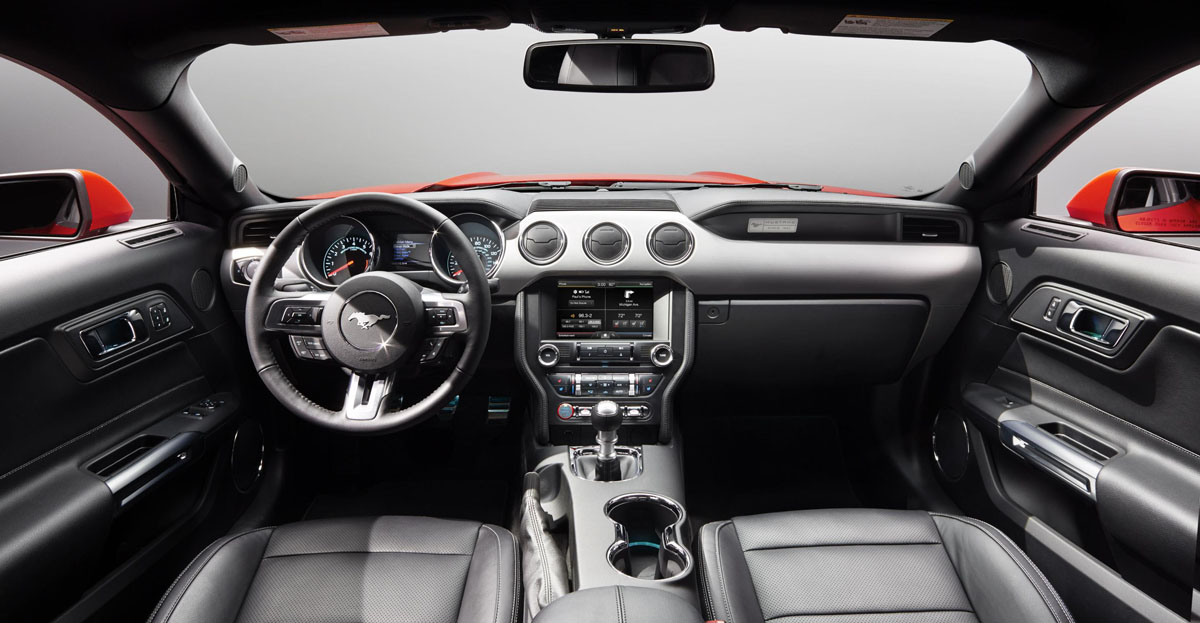
Smarter than your average pony
The all-new Mustang features a significant amount of innovative technologies providing drivers with enhanced information, control and connectivity when they want it. From Intelligent Access with push-button start to SYNC® and MyKey® in every Mustang built, plus available Track Apps, MyColor gauges and new Shaker Pro audio system, drivers will be able to customize their time behind the wheel.
The feeling of freedom and confidence Mustang instills in its drivers is amplified when they can take control of how the car behaves. On a twisty back road or a weekend track day, the driver can tap the toggle switches on the console to quickly adjust steering effort, engine response, and transmission and electronic stability control settings using the available Selectable Drive Modes to create the perfect Mustang at any time.
The advanced new Ford-developed stability control system is tuned to maximize Mustang’s dynamic capabilities. When the time comes to turn up the wick at the track, Mustang GT includes standard launch control that enables drivers to achieve smooth, consistent starts every time.
When it’s time to back off and relax for the drive home, available advanced driver-assist features including Blind Spot Information System with cross-traffic alert and adaptive cruise control can help ease the load, while SYNC AppLink™ lets drivers control their smartphone apps to listen to their favorite form of entertainment.
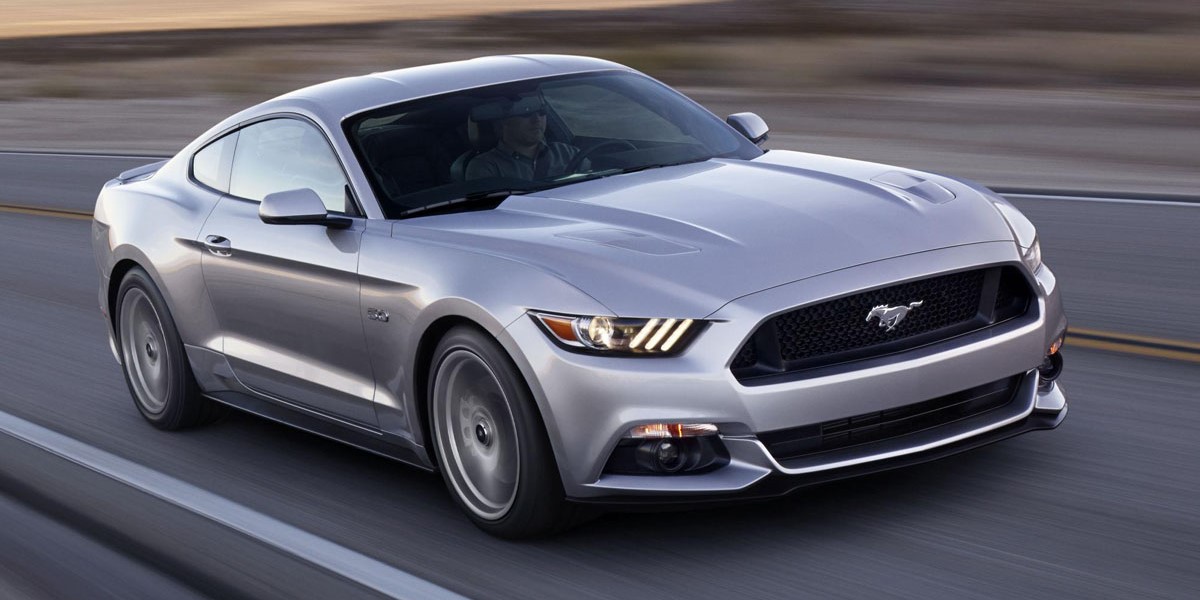
HORSEPOWER UNLEASHED MOTIVATING THE ALL-NEW FORD MUSTANG
- 5.0-liter V8 headlines all-new Ford Mustang lineup with 435 horsepower and 400 lb.-ft. of torque and improved power-to-weight ratio
- New 2.3-liter EcoBoost® brings turbocharging and direct injection to Mustang with 310 horsepower and 320 lb.-ft. of torque – best-ever power density from a Ford engine
- Manual transmission provides smoother shifting than previous Mustangs; automatic transmission features steering wheel-mounted paddle shifters and downshift rev-matching
The all-new 2015 Ford Mustang offers three great engines including a standard 300-horsepower V6, a brand-new 310-horsepower EcoBoost® or an upgraded 435-horsepower V8. Each powerplant is available with either a manual or automatic transmission that makes the pony car a great all-around performer – no matter how the equipment is mixed and matched to suit any individual driving style.
The fewer the pounds a car carries for every unit of horsepower generated by the engine, the quicker and nimbler it feels, making power-to-weight ratio a key measure of performance. A recent study by Autoblog of cars currently available in the U.S. market puts Mustang at the top of the charts in power-to-weight ratio for all three price categories a customer can specify.
Mustang extends its lead further for 2015 with the EcoBoost-powered fastback now carrying fewer than 11.4 pounds per horsepower; Mustang GT has as few as 8.52 pounds per horsepower.
Less is more, EcoBoost comes to Mustang
The addition of a new 2.3-liter EcoBoost engine brings turbocharging to the Mustang powertrain lineup. This engine was designed specifically for Mustang, to meet the needs of drivers looking for outstanding performance and fuel efficiency.
The geometry of the EcoBoost intake manifold and turbocharger housing has been optimized to provide better breathing and higher output in Mustang. Producing 310 horsepower and 320 lb.-ft. of torque, the 2.3-liter EcoBoost engine fits the bill for a true Mustang powerplant – with the highest power density yet from a Ford engine.
“This EcoBoost engine delivers the healthy output Mustang drivers expect, regardless of the car’s speed,” said Scott Makowski, EcoBoost powertrain engineering manager. “It delivers where a Mustang driver expects it to – with a broad, flat torque curve and great driveability under any conditions.”
The newest member of Ford’s global EcoBoost engine family, the 2.3-liter continues to take advantage of state-of-the-art technologies including direct fuel injection, twin independent variable camshaft timing and turbocharging to produce big-engine power and torque with improved fuel efficiency.
The 2.3-liter EcoBoost is the first Ford engine to use a low-inertia twin-scroll turbocharger that provides quicker boost response while enabling lower emissions and improved efficiency. The cylinder head features an integrated exhaust manifold that separates the inner and outer pairs of cylinders into each of the two inlet passages to the turbo.
Keeping the exhaust pulses separated from the next cylinder in the firing order virtually eliminates mixing losses and maximizes the pulse energy to the turbine wheel. The result is similar performance to a more complex twin-turbocharger configuration, meaning quicker turbine spin-up and torque delivery when the driver needs it for passing maneuvers.
The separated exhaust ports also enable the exhaust valves to stay open longer for reduced pumping losses that improve specific fuel consumption compared to a single-scroll turbocharger configuration.
With a compact mill generating nearly 135 horsepower per liter and more than 139 lb.-ft. of torque per liter – powering a performance car whose drivers are more inclined to use it – ensuring engine durability was critical. Enhancements to the Mustang EcoBoost engine to withstand the added stresses include:
- Forged-steel crankshaft
- Piston-cooling jets
- Steel piston ring carriers
- Premium bearing materials
- Upgraded valve seat materials
- Forged-steel connecting rods
- High-pressure die-cast aluminum cylinder block with ladder-frame bearing caps
- Deep-sump, die-cast aluminum oil pan
The beating heart of a pony
No Ford Mustang engine lineup would be complete without a great V8 engine at its core. The 5.0-liter V8 powers into a new generation with a host of upgrades that help it breathe better, especially at higher engine speeds. Many of these changes are derived from lessons learned in developing the special-edition 2012 Mustang Boss 302.
Getting air into the cylinders and exhaust out is key to generating more power and torque from any engine. That has been the focus in the development of this V8, which features:
- Larger intake valves
- Larger exhaust valves
- Revised intake camshafts
- Revised exhaust camshafts
- Stiffer valve springs ensure valves close completely at high rpm
- New cylinder head casting – revised ports provide straighter path to the valves for less restrictive intake and exhaust flow; combustion chamber modifications accommodate larger valves
- Sinter forged connecting rods are lighter and more durable for high-rpm operation
- Redesigned piston tops – deeper cutouts clear the new larger valves
- Rebalanced forged crankshaft to support higher-rpm operation
These upgrades have boosted output of the V8 to 435 horsepower and 400 lb.-ft. of torque.
A new intake manifold includes charge motion control valves to partially close off port flow at lower engine speeds. This increases the air charge tumble and swirl for improved air-fuel mixing, resulting in better fuel economy, improved idle stability and lower emissions.
The variable camshaft timing on the intake side now has a greater range of adjustment available thanks to mid-lock phasers. This enables better optimized control of the valve timing over a broader range of engine speeds and loads for improved fuel economy and emissions.
Shifting gears
More than most drivers, Mustang owners like to take control and shift for themselves. Whether they select a fully manual gearbox or the updated automatic transmission, the experience will be better than in any previous pony.
The manual has a new shift linkage design for easier engagement and improved precision. The shift lever is now positioned closer to the driver and away from the cupholders, creating a clear path for shifting.
Mustang blends outstanding all-around performance and everyday usability. Drivers who prefer to let the car handle the shifting during their daily work run, but who still want to take control when the roads get twisty, will appreciate the new steering wheel-mounted shift paddles with rev-matching downshifts – now standard with the SelectShift® six-speed automatic transmission.
The automatic also features a redesigned case with cast-in ribs that help make it stiffer and reduce weight. Internally, clutches are optimized and operating temperature increased to reduce friction. The output shaft is now supported by a ball bearing that enables a top speed of 155 mph for Mustang GT.
With a choice of powertrains to suit driving preferences and lifestyles, the new Mustang has cutting-edge technology under the hood to match its modern design. Yet regardless of engine choice, the car remains quintessentially Mustang.
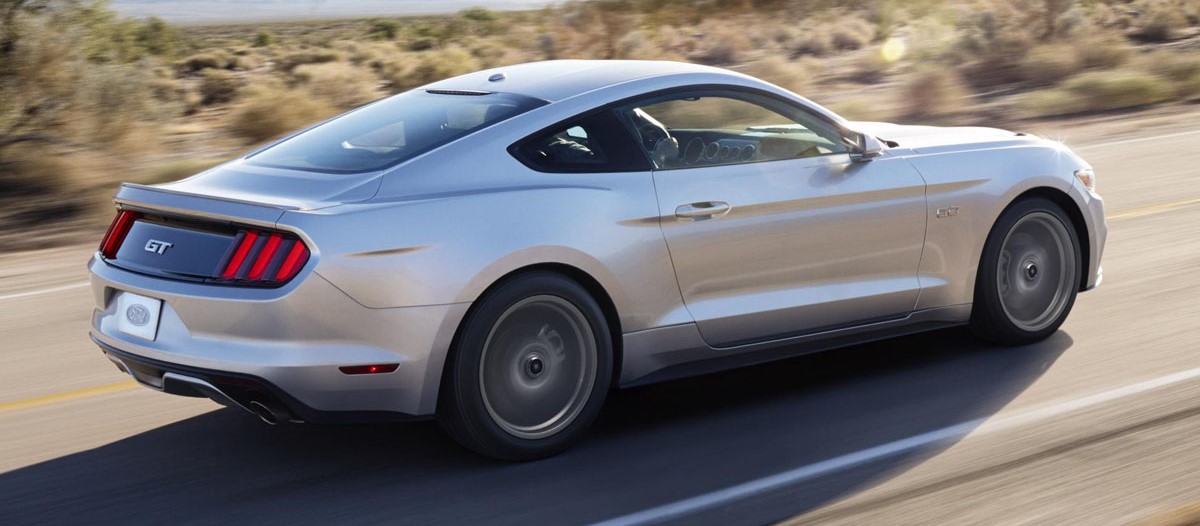
POWER, FUEL EFFICIENCY AND ADVANCED TRANSMISSION OPTIONS; NEW FORD MUSTANG IS TAILORED TO DRIVER PREFERENCE
- New 2.3-litre EcoBoost brings turbocharging to the new Mustang with exceptional power, torque and fuel efficiency
- 5.0-litre V8 engine delivers power and torque fans expect from the iconic brand
- Manual transmissions provide smooth shifting, automatic transmissions feature steering-wheel-mounted paddle shifters
Brentwood, Oct 2. 2014 – The all-new Ford Mustang offers a choice of advanced engines and manual or automatic transmissions, delivering power and performance worthy of the Mustang badge in any specification.
The all-new 2.3-litre EcoBoost engine brings turbocharging to the Mustang powertrain line-up. Designed to meet the needs of drivers looking for outstanding performance and fuel efficiency, this EcoBoost engine has been developed specifically for Mustang. The intake manifold and turbocharger housing are optimised to provide better breathing and higher output in Mustang.
With output of 314 PS and 434 Nm of torque for Europe, this EcoBoost engine fits the bill for a true Mustang powerplant.
“This EcoBoost engine delivers the healthy output that Mustang drivers expect regardless of the speed with a broad, flat torque curve and great driveability under any conditions,” said Scott Makowksi, Ford EcoBoost powertrain engineering manager.
The newest member of Ford’s global family of EcoBoost engines, the 2.3-litre engine leverages state-of-the-art technologies including direct fuel injection, twin independent variable camshaft timing and turbocharging to produce big-engine power and torque with improved fuel efficiency.
This is the first Ford engine to utilise a low-inertia twin-scroll turbocharger that provides quicker boost response while enabling lower emissions and improved efficiency. The cylinder head features an integrated exhaust manifold that separates the inner and outer pairs of cylinders into each inlet passage to the turbo.
Keeping the exhaust pulses separated from the next cylinder in the firing order eliminates mixing losses and maximises pulse energy to the turbine wheel. The result is quicker torque delivery when the driver needs it for passing manoeuvres and similar performance to a twin-turbocharger configuration.
The separated exhaust ports also enable the exhaust valves to stay open longer for reduced pumping losses that improve specific fuel consumption by about 1 per cent.
With such high power output, ensuring durability was critical. Enhancements to the Mustang EcoBoost engine to withstand the stresses include:
- Forged-steel crankshaft
- Piston-cooling jets
- Steel piston ring groves
- Premium bearing materials
- Upgraded valve seat materials
- Forged-steel connecting rods
- High-pressure die-cast aluminium cylinder block with ladder-frame bearing caps
- Deep-sump, die-cast aluminium oil pan
The beating heart of a Mustang
No Ford Mustang engine line-up would be complete without a great V8 engine at its core. The 5.0-litre V8 engine powers into a new generation with a host of upgrades that enable it to breathe better, especially at higher engine speeds.
Getting air into the cylinders and exhaust out is the key to generating more power and torque from any engine, and that has been the focus of development on the V8, which features:
- Larger intake valves
- Larger exhaust valves
- Revised intake camshafts
- Revised exhaust camshafts
- Stiffer valve springs – delivering precise control of valves high rpm
- New cylinder-head casting – revised ports that provide a straighter path to the valves for less-restrictive intake and exhaust flow; combustion chamber modifications accommodate larger valves
- Sinter forged connecting rods – lighter and more durable for high-rpm operation
- Redesigned piston Crowns – deeper pockets clear the new larger valves
- Rebalanced forged crankshaft – supports higher-rpm operation
These upgrades are projected to generate 418 PS and 524 Nm of torque for Europe.
A new intake manifold includes charge motion control valves to partially close off port flow at lower engine speeds. This increases the air charge tumble and swirl for improved air-fuel mixing. This results in better fuel economy, idle stability and lower emissions.
The variable camshaft timing on the intake side now has a greater range of adjustment available thanks to mid-lock phasers. This enables better optimised control of the valve timing over a broader range of engine speeds and loads for improved fuel economy and emissions.
Transmissions
Mustang blends outstanding all-around performance and everyday usability. Drivers who prefer to let the car handle the shifting during their daily work run, but still want to take control when the roads get twisty, will appreciate the new steering-wheel-mounted shift paddles with rev-matching downshifts that are now standard with the Select-Shift six-speed automatic transmission.
The automatic also features a redesigned case with cast-in ribs that help make it stiffer and reduce the weight. Internally clutches have been optimised and the operating temperature has been increased to reduce friction.
The new Mustang’s Getrag manual transmission has a shift linkage design for improved precision and slick engagement.
With a choice of powertrains to match driving styles and lifestyles, the new Mustang has contemporary technology under the hood to match its modern design and yet remain quintessentially Mustang.
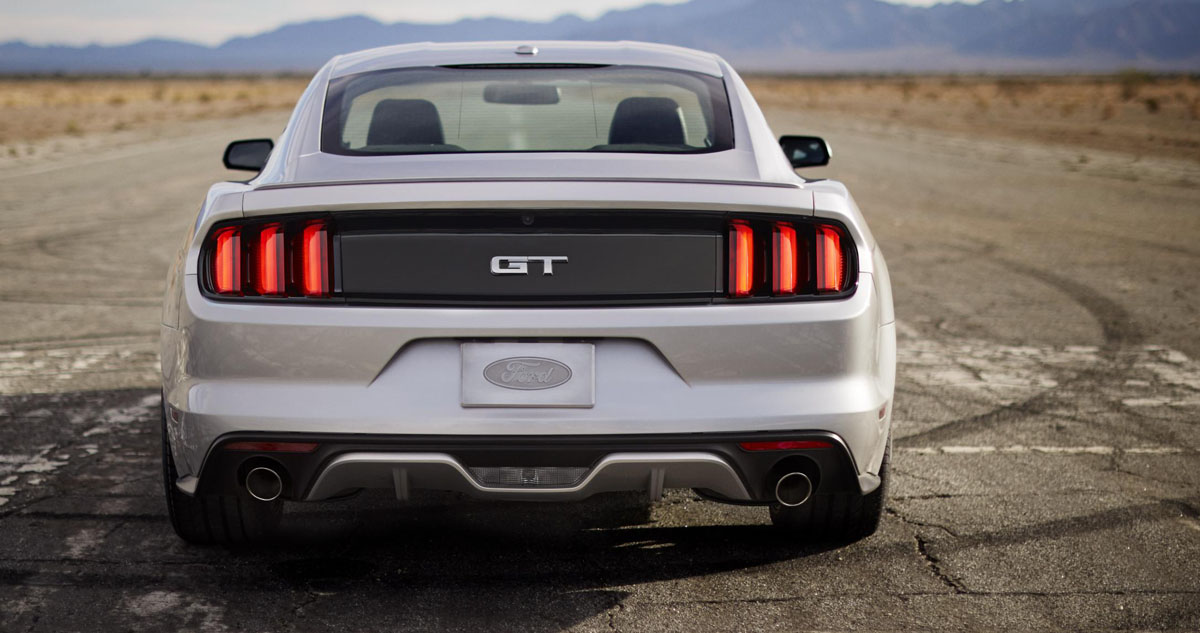
AGILE FORD MUSTANG FEATURES ALL-NEW SUSPENSION; PERFORMANCE PACK RAISES BAR FOR HANDLING AND BRAKING
- 2015 Ford Mustang features new, fully independent front and rear suspension mated with stronger and lighter platform for improved handling and ride quality through better wheel and body control
- Three new brake systems ensure new Mustang stops as well as it accelerates and turns
- Available performance packs for Mustang EcoBoost® fastback and convertible and Mustang GT fastback raise the bar for handling and braking performance on both the road and the track
With new fully independent front and rear suspension systems, the all-new sixth-generation Ford Mustang is expected to be the nimblest and most comfortable example of the breed to date. Mustang EcoBoost® and Mustang GT fastback customers can also add an available performance pack for maximum all-around capability, continuing 50 years of Mustang personalization.
“When we began development of the sixth-generation Mustang, we knew we had a challenge ahead of us to beat ever-increasing customer expectations, as well as new competitors in the marketplace,” said Raj Nair, Ford group vice president, Global Product Development. “We added content where it mattered – including an independent rear suspension for better handling and ride, and bigger brakes for better, shorter and more consistent stops. We also doubled the number of airbags.
“Even with all of that extra hardware, smart engineering throughout every component of this car enabled us to achieve a base curb weight of 3,524 pounds for the new Mustang EcoBoost fastback – just six pounds more than the lightest 2014 Mustang V6, and still the best power-to-weight ratio of any car available in the United States for under $50,000.”
Building on a solid foundation
With an all-new platform and fully independent suspension, the 2015 Ford Mustang sets new handling benchmarks for the brand, achieving world-class performance in both dynamics and ride quality.
“In order to develop precise and predictable handling characteristics, a car needs a solid platform where the suspension mounts don’t move relative to one another,” said Tom Barnes, Mustang vehicle engineering manager. “The structure of the new Mustang is much more resistant to twisting, with 28 percent more torsional stiffness for the fastback and a 15 percent improvement for the convertible.”
Despite being so much stronger, this is a very efficient horse, with a body-in-white that is actually lighter than the previous version. This was achieved through extensive use of advanced technologies and materials including hydroforming, laser welding and high-strength steels. Lightweight aluminum is used for the hood and front fenders to help reduce body mass and improve the weight balance.
Attention to detail throughout the design process yielded significant weight savings that helped to offset the increases from adding performance-enhancing features such as larger, more powerful brakes and independent rear suspension. The result is a vehicle that is more capable than before while remaining significantly lighter overall than key competitors.
The structure of the 2015 Mustang is also designed to meet new, more stringent crash safety standards. Some of the other components now made of aluminum include the rear suspension knuckles, rear axle housing on automatic transmission cars, rear control arms and rear brake calipers. Even parts made of steel and other materials such as the hollow rear stabilizer and the new seats have been intelligently designed to meet performance standards while keeping weight down.
“We added a lot of content to the new Mustang in order to hit our performance targets and meet today’s customer expectations,” said Dave Pericak, Mustang chief engineer. “With a base curb weight of 3,524 pounds for Mustang EcoBoost fastback, and increases ranging from six pounds to 87 pounds for V6 and GT fastbacks, Mustang is still substantially lighter than the competition.”
Mustang EcoBoost fastback has best-ever weight distribution for a Mustang, with 52 percent of its weight over the front axle and 48 percent to the rear, while Mustang GT has 53 percent of its mass on the front wheels. In combination with a lineup of new or upgraded powerplants, Mustang improves on its already leading power-to-weight ratios. Mustang EcoBoost carries fewer than 11.36 pounds per horsepower, while Mustang GT has as little as 8.52 pounds per horsepower.
With a stronger yet lighter structure to build on, the hardware was added to meet aggressive performance targets. Every new Mustang features an all-new integral-link independent rear suspension. The suspension architecture is based on a lower control arm, integral link, upper camber link and a toe link. The geometry, springs, dampers and bushings have all been specifically modified and tuned to deliver improved mechanical grip for this high-performance application.
The new suspension geometry of Mustang now generates twice as much anti-squat and anti-lift force for better pitch control to keep the body level under hard acceleration and braking. New aluminum alloy rear knuckles help reduce unsprung mass to enable the tires to follow the road for better ride and handling.
At the front, a new non-isolated perimeter subframe replaces several individual crossmembers to help stiffen the structure while reducing mass, contributing to a better foundation for more predictable wheel control that benefits handling, steering and ride quality.
The new double-ball-joint front MacPherson strut system enables the use of larger, more powerful brakes without resorting to excessive wheel offsets that would hurt steering feel. Like the rear, the front end contributes to improved pitch stability with additional anti-dive in the geometry.
The total system now does a much better job of keeping the four Mustang tires in contact with the road where they can contribute to improved dynamics while making cruising and daily commutes more comfortable.
This is expected to be the best-stopping Mustang yet. Three brake packages will be available:
- Mustang V6, Mustang EcoBoost: Two-piston, 43-millimeter floating calipers, 320- millimeter rotors, front; single-piston, 45-millimeter calipers, 320-millimeter rotors, rear
- Mustang EcoBoost performance pack, Mustang GT: Four-piston, 46-millimeter fixed calipers, 352-millimeter rotors, front; single-piston, 45-millimeter calipers, 330-millimeter rotors, rear
- Mustang GT performance pack: Six-piston, 36-millimeter Brembo™ calipers, 380-millimeter rotors, front; single-piston, 45-millimeter calipers, 330-millimeter rotors, rear
The standard brake package on Mustang GT is equivalent to the system used for the 2014 Mustang GT track package. The new GT performance package includes the same brake package found on the 662-horsepower 2014 Shelby GT500.
When maximum performance is needed
“We already set a very high standard for Mustang driving dynamics with the 2012 Mustang Boss 302, and our goal was to go above and beyond that with the performance pack on this new car,” said Pericak. “Mustang is all about performance and customization, and the available performance packs give our customers what they are looking for straight from the factory.”
The 2015 model is already the best-handling, best-braking standard Mustang ever right out of the box. Drivers looking to take their cars to even higher levels of capability can add a performance pack to Mustang EcoBoost fastback or convertible or Mustang GT fastback.
Both performance packs get:
- Retuned springs, bushings and monotube rear dampers
- Additional cooling capability for track-day durability
- Thicker rear sway bar
- K-brace connecting strut towers to bulkhead
- Unique tuning for ABS, electronic stability control and electric power-assisted steering
- Center gauge pack
The 2015 Mustang EcoBoost performance package also includes:
- Front brakes: Four-piston, 46-millimeter fixed aluminum calipers with 352-millimeter rotors
- Rear brakes: Single-piston, 45-millimeter floating iron calipers with 330-millimeter rotors
- Unique 19×9-inch alloy wheels painted Ebony Black with Pirelli 255/40R19 Y-speed-rated tires front and rear
- 3.55:1 final drive ratio
The 2015 Mustang GT performance package includes:
- Front brakes: Brembo six-piston, 36-millimeter fixed aluminum calipers with 380-millimeter rotors
- Rear brakes: Single-piston, 45-millimeter floating iron calipers with 330-millimeter rotors
- Unique 19×9-inch Ebony Black painted alloy wheels with Pirelli 255/40R19 Y-speed-rated tires, front; 19×9.5-inch alloy wheels with Pirelli 275/40R19 Y-speed-rated tires, rear
- Strut tower brace
- 3.73:1 final drive ratio with Torsen differential
- Unique front splitter to channel cooling air to the front brakes
“We set out to create an all-new Mustang that would go, handle and stop better than any previous Mustang, while also being a better all-around daily driver,” said Pericak.
The results speak for themselves – during track testing, the 2015 Mustang GT with performance package consistently beat the lap times of the 2012-2013 Mustang Boss 302.
FORD ENGINEER IS COMPOSER, CONDUCTOR AND ORCHESTRA FOR SOUNDTRACK OF ALL-NEW MUSTANG
- Powertrain soundtracks reinforce essential nature of all-new Ford Mustang
- Each of three available engines has a distinct voice, while remaining quintessentially Mustang
- Building on a more solid foundation gives the sound engineers increased flexibility to tune each engine
Driving Ford Mustang is a visceral experience, combining a visual feast for the eyes with a seat-of-the-pants feeling on the road and the audible entertainment of a powerful engine. Like a film without a soundtrack, a Mustang without the right engine growl just wouldn’t be complete.
“Our goal in developing this new generation was to create a sports car that is quintessentially Mustang, with contemporary, world-class levels of performance and refinement,” said Dave Pericak, Mustang chief engineer. “We created an exceptionally solid platform to give us the flexibility we need to meet our diverse range of targets.”
Shawn Carney, powertrain noise, vibration and harshness engineer for Mustang, is tasked with making sure no matter what engine is installed, every new Mustang sounds like a Mustang should. Like great cinematic sound editors and composers, Carney crafts the soundscape that enhances the pony car driving experience.
Laying down a solid foundation
Film crews head to a sound stage, and musicians to a recording studio to get a clean backdrop to build on – free of unwanted noise. Similarly, Carney and his diverse team of engineers worked with the rest of the product development crew to craft a more refined background for the Mustang soundtracks.
“In addition to the usual suspects you expect to hear inside the car, like the engine and exhaust, the body structure can become an incremental source of unwanted noise,” explained Carney. “Body panels can act like speakers, amplifying vibration and sound inputs from the road, powertrain and wind.
“The Mustang engineering team – from studio, chassis, body, powertrain, dynamics, NVH and aerodynamics – collaborated to create an improved platform that attenuates many of the noises drivers don’t want to hear,” he added.
With more than a decade of experience working on Mustang NVH, Carney was handed responsibility for delivering the powertrain sound quality for all Mustangs. With three engines including a new turbocharged EcoBoost® offering, a 3.7-liter V6 and the legendary 5.0-liter V8, Carney and team set out to deliver three unique aural experiences – all while maintaining the common thread that connects the Mustang heritage.
Mustang’s sleek new profile helps diminish wind noise while also reducing lift and drag. The stiffer structure provides a rigid platform for more precise handling and improved ride quality, while transmitting less mechanical racket and road noise into the cabin.
Key design details – the shape of the alternator housing’s cooling vents, additional layers of door seals, acoustic windshield and the subtle lines of the mirror sails – all contribute to lowering the noise floor of the new platform.
The V8 engine rumble has long been considered the mating call of Mustang, so the GT receives a revised exhaust system to lay the bass note and set the rhythm from the first crank of the engine. Upfront, a redesigned induction sound tube matches the beat of the exhaust – note for note – playing directly into the cabin. The tube is now more centrally placed for a more natural balance.
The upgraded 3.7-liter V6 engine now has a more refined growl that communicates the performance a driver can expect from 300 horsepower underhood. Engineers borrowed a few tuning tricks from Mustang GT to provide this V6 with a grownup, though still very racy sound. Heads will turn as the new 3.7-liter Mustang storms by.
Composing a modern classic
The newest addition to the Mustang powertrain lineup is the 2.3-liter EcoBoost engine. With 310 horsepower and 320 lb.-ft. of torque, this powerplant ranks well up the list in the pantheon of Mustang engines. A combination of turbocharging, direct injection and twin independent variable camshaft timing helps this compact mill churn out nearly 135 horsepower per liter and more than 139 lb.-ft. of torque per liter – the best-ever power density from a production Mustang engine.
“Based on our long experience with V8 and V6 engines, we already had a good idea of what those Mustangs should sound like,” said Carney. “The new Mustang EcoBoost needed to have its own voice and its own DNA, while still being linked to the other models.
“We knew the EcoBoost was going to be straightforward and refined,” he added, “but it also had to project its own essence while still being unmistakably connected to the brand.”
The team benchmarked a variety of great cars, many of which had their own unique sounds that reflected the character of the vehicle. None were considered right for Mustang, but all had something to offer. Carney deconstructed key characteristics of those sounds, then arranged the notes to produce a soundtrack that matched the targeted character of the Mustang EcoBoost.
“Using computer simulation tools that take into account the basic hardware we have to work with in a given car – this defines the limits of where we can acoustically take a car – we created several sound concepts,” said Carney. “We enlisted our core audience, and solicited feedback from multiple Mustang enthusiast groups to confirm our direction for the EcoBoost sound.”
Even though the 2.3-liter EcoBoost beats the performance levels of earlier V8 engines, the physical characteristics of a smaller-displacement turbo engine meant it wouldn’t sound like its bigger brother, nor should it. The greatest performance cars in the world use a wide range of engine configurations, and each produces a distinct soundtrack.
The team ultimately decided on a sound that is athletic and youthful to accompany the nimbler platform of the all-new Mustang. At the same time, the Mustang EcoBoost has a traditional American feel, emitting a low-frequency sense of powerfulness that is a subtle reminder of the DNA it shares with the V6 and V8 Mustangs.
The EcoBoost engine incorporates a balance shaft for smoother operation, and even gets a unique mounting subframe with active hydraulic engine mounts to provide an uncommonly smooth idle. When paired with an automatic transmission, Mustang EcoBoost also adds a pendulum damper in the torque convertor. Manual transmissions use a new dual-mass flywheel for a smoother driving experience.
Just as a producer in the studio can rebalance frequencies to get the most harmonious sound from a band, Carney has similar tools at his disposal with active noise control. Microphones are mounted in the cabin to measure what the driver hears and provide real-time feedback control. The audio system is used to generate opposing sound waves to cancel out undesirable frequencies – such as low-speed “boominess” – while simultaneously amplifying the “instruments and notes” that reinforce the car’s strength, responsiveness and addictive power.
“Our goal with all three powertrains was to provide the driver with an engaging experience including clear feedback about what the car is doing at all times, but without isolating the driver from the action,” said Carney. “When tuning the sound quality of any Mustang, I often describe what I do as ‘letting you hear what you feel,’ and aiming for that which is unmistakably Mustang – regardless of what engine is in front of you.”
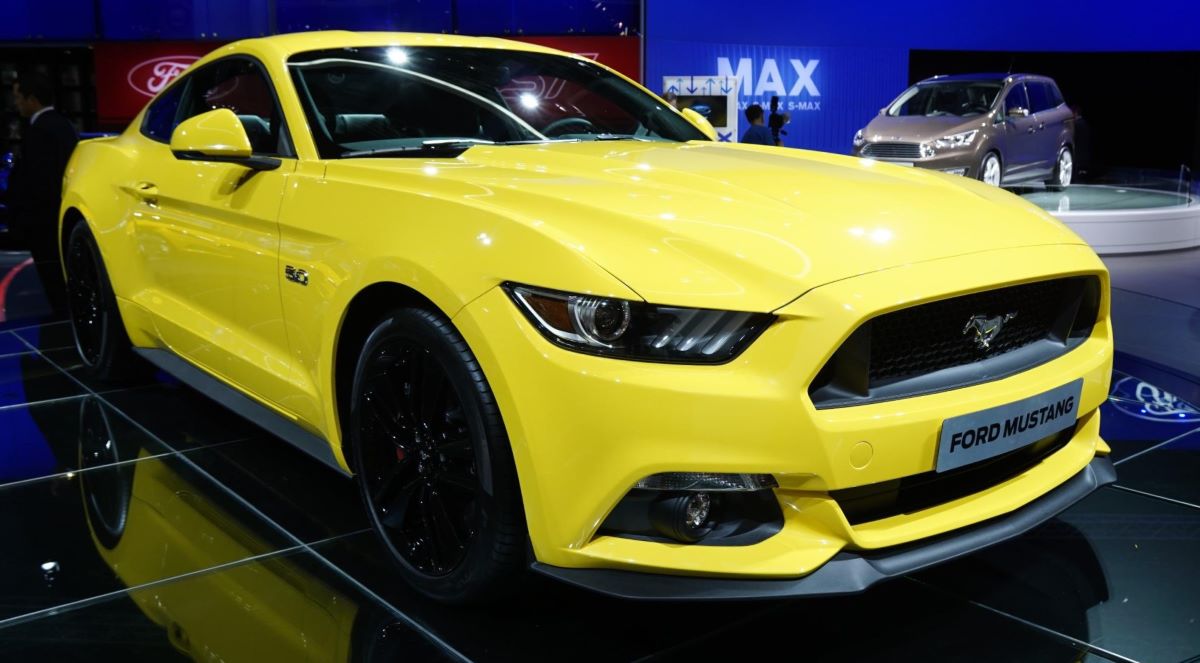
NEW FORD MUSTANG READY FOR EUROPE WITH SLEEK DESIGN, ADVANCED TECHNOLOGY AND WORLD-CLASS PERFORMANCE
- European specification new Ford Mustang makes public debut in Paris; the first Mustang confirmed to go on sale across the region after 50 years of production will arrive in 2015
- New Ford Mustang fastback and convertible models promise world-class levels of performance and refinement; sleek design retaining classic Mustang key design elements
- New Mustang will deliver power of choice in Europe, from 5.0-litre V8 engine to the all-new fuel-efficient 2.3-litre EcoBoost engine
- State-of-the-art suspension is optimised to deliver world-class handling, precise steering control and ride comfort; innovative technology for enhanced control and connectivity
BRENTWOOD, Oct 2, 2014 – The new Ford Mustang will make its European production debut at the 2014 Paris Motor Show.
The new Ford Mustang fastback and convertible models will go on sale across Europe in 2015 for the first time after 50 years of production, and promise world-class levels of performance and refinement while embracing the Mustang’s half-century of heritage and status as a global icon.
“The Mustang’s reputation for performance and its iconic status as a symbol of freedom and optimism precedes it even in those parts of the world where the car has never been sold,” said Stephen Odell, Ford executive vice president, Europe, Middle East and Africa. “The new Mustang is modern, technologically advanced and creative, without forgetting the heritage that has inspired Ford customers for generations.”
More than nine million Mustangs have been sold since it was first launched in 1964. The world’s most-liked vehicle on Facebook, Mustang has made thousands of appearances in film, television, music and video games.
The new Mustang has been developed with world-class performance, driving dynamics and ergonomics in mind – and includes a significant amount of advanced driver convenience and driver aid technologies.
“The new Mustang is one of the most hotly anticipated cars ever, we are very excited to now give drivers in Europe the opportunity to experience the real thing,” said Roelant de Waard, vice president, Marketing, Sales & Service, Ford of Europe.
Unmistakably Mustang
The clean-sheet design of both Ford Mustang fastback and convertible evokes the essential character of the vehicle, retaining key design elements of the classic Mustangs recognisable to car fans across Europe, including the long sculpted bonnet and short rear deck, with a contemporary execution.
“You only get one chance to make a first impression and when you see this car, you immediately see a Mustang strong and true,” said Moray Callum, Ford executive director, design, The Americas.
Several key design features define the new Ford Mustang, including:
- A low roof height and wide stance
- Sleek profile enabled by steeply sloped windshield and rear glass
- Three-dimensional, tri-bar taillamps
- Contemporary execution of the iconic car’s signature trapezoidal grille and shark-bite front fascia
Ford Mustang convertible drivers will appreciate the standard multilayer insulated cloth top that gives the car an upscale appearance and a quiet cabin. The top has a sleek profile when folded for open-air motoring.
Large, clear instrumentation puts vehicle information right in front of the driver in the roomy cabin with an aviation-inspired cockpit, while ergonomic and tactile switches and knobs provide control. The vehicle’s width and new rear suspension contribute to improved shoulder and hip room for passengers and a usefully shaped bootspace that can accommodate two golf bags.
The Mustang experience
The way Ford Mustang looks, drives and sounds is key to the visceral experience. The Ford Mustang offers outstanding power options and a sophisticated new chassis designed to meet the driving dynamics expectations of European drivers.
Ford’s acclaimed 5.0‑litre V8 engine – yielding 418 PS and 524 Nm of torque for Europe – is joined by an all-new 2.3-litre EcoBoost engine that brings state-of-the-art technology to Mustang; delivering turbocharged performance with the fuel efficiency and CO2 emissions demanded by Europe’s car consumers.
“This EcoBoost engine delivers where a Mustang driver expects it to with a broad, flat torque curve that pours out when you stand on it for easy passing or hustling down a twisty road,” said Dave Pericak, Mustang chief engineer.
The Mustang’s 2.3-litre EcoBoost engine uses direct injection, variable cam timing and turbocharging to deliver usable performance. A unique intake manifold and turbocharger housing enable it to deliver the performance Mustang drivers expect, with 314 PS and 434 Nm of torque for Europe. An automatic transmission option features steering wheel-mounted shift paddles that deliver convenience and control for drivers.
A Mustang for the true driving enthusiast
The new Ford Mustang features all-new front and rear suspension systems. At the front, a new perimeter subframe helps to stiffen the front structure while reducing mass, providing a strong foundation for more predictable wheel control that benefits handling, steering and ride.
The new double ball-joint front MacPherson strut system also enables the use of large, powerful brakes. Both 2.3-litre EcoBoost and V8-powered GT Mustang models will feature performance brake packages behind standard 19-inch wheels in Europe.
At the rear is an all-new integral-link independent rear suspension. The geometry, springs, dampers and bushings all have been specifically modified and tuned for this high-performance application, and are well-suited to European roads and high speed driving culture. New aluminium rear knuckles help reduce unsprung mass for improved ride and handling.
Smart technology
The new Mustang features a significant number of innovative technologies providing drivers with enhanced information, control, and connectivity when they want it.
On a twisty road or a weekend track day, the driver can tap the toggle switches on the console to quickly adjust steering effort, engine response, and transmission and electronic stability control settings using the available Selectable Drive Modes to create the perfect Mustang at any time.
The new Mustang will be among the first vehicles in Europe to offer SYNC 2. Ford’s advanced infotainment system features a high-resolution, 8-inch colour touch screen and advanced voice control for easier access to audio, navigation, climate control and compatible mobile phones.
SYNC 2’s navigation system also offers a split-screen display with detailed intersections, spoken street names, 3D highway junction and landmark views, and the Michelin travel guide. SYNC 2 enables drivers to issue simpler “one-shot” navigation destinations, and to ask the system to “play” a desired artist. Simply pushing the voice control button and saying “I’m hungry” will bring up a list of local restaurants, which you can then get directions to.
“From day one, we knew if we were going to build a new Mustang, we had to do it right,” Pericak said. “We built a new Mustang from the ground up that is fast, great-looking, refined and efficient, without losing any of the raw appeal that people around the world have associated with Mustang for decades.”

MUSTANG HIGHLIGHTS FORD RACING PACE CAR LINEUP AT FORD CHAMPIONSHIP WEEKEND
- When the cars of the NASCAR Sprint Cup Series take the track on Nov. 17 for the Ford EcoBoost 400 season finale at Homestead-Miami Speedway, they will be led by a highly-customized Mustang that is featured as the hero car in the upcoming Hollywood movie, “Need for Speed” and is also playable in the upcoming Electronic Arts videogame entitled “Need for Speed Rivals.” The pace car will be driven by one of the film’s stars, Ramon Rodriguez.
- The “Need for Speed” Mustang was created solely for the movie and features a custom-designed wide body with unique 22-inch alloy wheels, and larger intakes to feed its supercharged V-8 engine.
- In addition to the “Need for Speed” Mustang, Ford will be using the all-new F-150 Tremor to pace the Ford EcoBoost 200 NASCAR Camping World Truck Series event on Friday, Nov. 15, and the Mustang GT500 for the NASCAR Nationwide Series Ford EcoBoost 300 on Saturday, Nov. 16.
Video of the ‘Need for Speed’ Mustang can be found at the bottom of this page
Race fans planning on attending Ford Championship Weekend at Homestead-Miami Speedway Nov. 15-17 already know they’re going to see stock cars racing side-by-side at breathtaking speeds. It’s the speed of another sort, however, that Ford Motor Co. hopes has them talking even more.
When the cars of the NASCAR Sprint Cup Series take the track on Nov. 17 for the Ford EcoBoost 400 season finale, they will be led by a highly-customized Mustang that is featured as the hero car in the upcoming Hollywood movie, “Need for Speed” and is also playable in the Electronic Arts video game entitled “Need for Speed Rivals.” The pace car will be driven by one of the film’s stars, Ramon Rodriguez.
“When the opportunity to showcase the ‘Need for Speed’ Mustang at our marquee event came up a few months ago it was a no-brainer to make it the centerpiece of Ford Championship Weekend,” said Tim Duerr, Ford Racing motorsports marketing manager. “We have always tried to incorporate some of our latest products that make up Ford’s versatile car and truck lineup, and we feel the three vehicles we’re using this year continues that trend.”
In addition to the “Need for Speed” Mustang, Ford will be using the all-new F-150 Tremor to pace the Ford EcoBoost 200 NASCAR Camping World Truck Series event on Friday, Nov. 15, and the Mustang GT500 for the NASCAR Nationwide Series Ford EcoBoost 300 on Saturday, Nov. 16.
“This lineup of new Ford vehicles is befitting of the three NASCAR championship races that we’ll be hosting at Homestead-Miami Speedway,” said track President Matthew Becherer. “Ford is a fantastic partner and we’re thrilled that its cars will be on display for a packed house and millions more to see on television across the world.”
The “Need for Speed” Mustang was created solely for the movie and features a custom-designed wide body created specifically for this new role with unique 22-inch alloy wheels, capable of supporting 900 horsepower, and larger intakes to feed its supercharged V-8 engine. Also keeping the engine cool is the enlarged lower grille with corner air intakes to cool the front brakes.
Designers also worked on reducing aerodynamic drag by using low profile mirrors and extended rocker panels. The splitter was also redesigned to provide better handling at high speeds. The rear spoiler and diffuser were created to improve airflow, reducing drag and giving additional traction for high-speed acceleration.
The movie, starring Aaron Paul, Dominic Cooper, Imogen Poots, Ramon Rodriguez, and Michael Keaton, will debut in theaters on March 14, 2014 while fans of the popular Electronic Arts video game series by the same name will be able to buy the latest version, “Need for Speed Rivals” later this month.
“The heritage of Mustang is unlike any other automobile in America,” said Steve Ling, Ford car marketing manager. “With Mustang being a central character in this racing-oriented movie, it seemed only fitting to showcase the car here at Homestead and help serve as a great springboard to our various celebrations recognizing 50 years of Mustang in 2014.”
This marks the 12th year Ford has served as title sponsor of Ford Championship Weekend.
